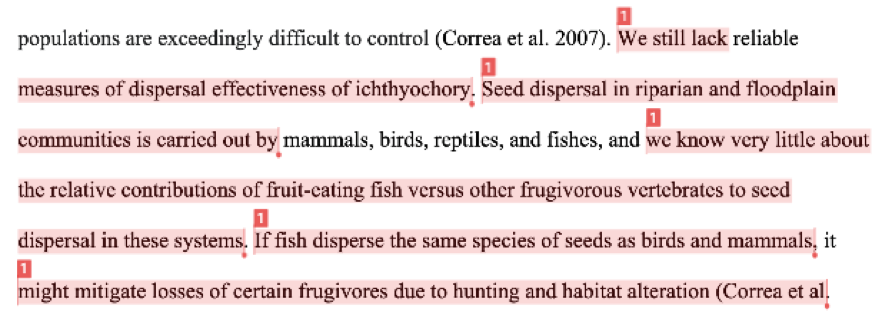Good academic writing engages previously published scholarship, sometimes by quoting the scholarship directly, more often by paraphrasing the ideas and giving credit to the source in a footnote or citation. One source problem that Turnitin sometimes highlights is a paraphrase where the student writer has used too much of the original language, what we call a too-close paraphrase. To help see what we mean by too-close paraphrase, consider the following passage from a student paper about ichthyochory—seed dispersal by fish. The writer has made some effort to change the source’s wording, but Turnitin still highlights much of the language as highly similar to the source.
Source:
[W]e still lack robust quantitative measures of dispersal effectiveness and recruitment effects of ichthyochory. [. . .] [S]eed dispersal in riparian and floodplain communities is carried out by a diverse suite of vertebrate dispersers. We know very little about the relative contributions of fruit-eating fish versus other frugivorous vertebrates to seed dispersal in these systems. If fish disperse the same species of seeds as birds and mammals, ecological redundancy among dispersers might mitigate losses of certain frugivores due to hunting and habitat alteration.1
Student:

Here the student has taken several steps to rework the original source in his own language:
- He has changed some of the wording: replaced “robust” with “reliable”; changed “diverse suite of vertebrate dispensers” to “mammals, birds, reptiles, and fishes.”
- He has merged the second and third sentences of the source.
- He has condensed some of the phrasing: replacing “ecological redundancy among dispersers” with “it.”
But as the volume of Turnitin highlighting suggests, the majority of the language is taken from the source. And the presentation of this language without quotes is misleading, as it suggests that the wording is the writer’s. The writer hasn’t altered or synthesized the source’s language enough to claim the words as his own—even if he credits the source in a citation. The writer also presents the information in the same order as the source does. He must change the syntax of the sentence more substantively to claim authorship of this language.
A fair paraphrase—one that thoroughly revises both the language and syntax of the source—looks like this:
| Fair Paraphrase: | Source: |
|---|---|
| We are also not sure about how great a role ichthyochory plays in our modern ecosystem relative to other vertebrate frugivory. Birds, mammals and reptiles are also found on floodplains. It is unclear whether they prefer to eat and disperse different types of seeds than fishes do, and whether some of these other frugivores may help compensate for the loss of fish dispersers.2 | [W]e still lack robust quantitative measures of dispersal effectiveness and recruitment effects of ichthyochory. [. . .] [S]eed dispersal in riparian and floodplain communities is carried out by a diverse suite of vertebrate dispersers. We know very little about the relative contributions of fruit-eating fish versus other frugivorous vertebrates to seed dispersal in these systems. If fish disperse the same species of seeds as birds and mammals, ecological redundancy among dispersers might mitigate losses of certain frugivores due to hunting and habitat alteration. |
Turnitin can help you find places in your paper where your language is too similar to the language of your sources. And the process of identifying and revising instances of too-close paraphrase can help you sharpen your judgment about fair use of sources when writing future papers.
Once you’ve discovered a too-close paraphrase, it’s easy to get stuck trying to accurately present the ideas of the source using language distinct enough to claim as your own. The following pages describe five strategies you might use to revise your work into a fair paraphrase—perhaps even one that improves the clarity and concision of the original.
1Correa, S.B., et al. 2015a. Neotropical fish-fruit interactions: eco-evolutionary dynamics and conservation. Biological Reviews, 90: 1274.
2All fair paraphrases on these pages were written by Maya Juman YC ’20.
